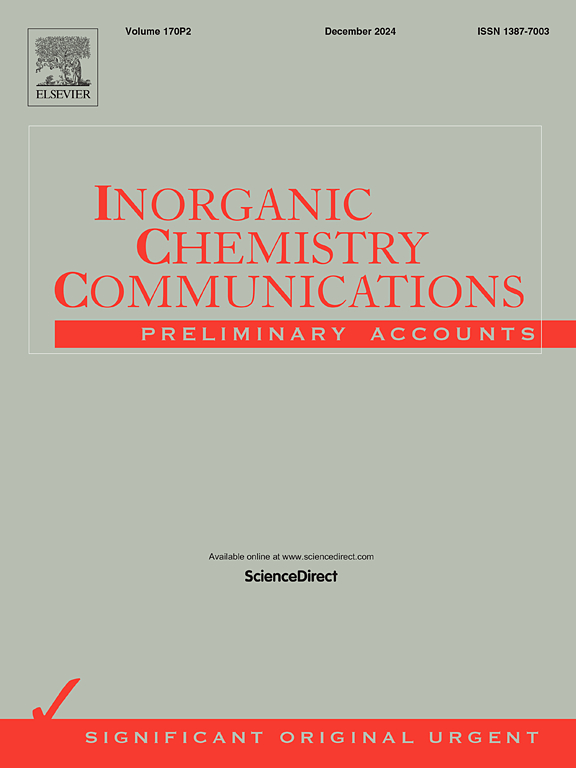Synthesis of Physalis minima L. based AuNPs: Insights in their antimicrobial, antioxidant and anticancer activity
IF 4.4
3区 化学
Q1 CHEMISTRY, INORGANIC & NUCLEAR
引用次数: 0
Abstract
AuNPs are currently gaining traction in biomedical realm because of their distinctive characteristics. Thus, the objective of the current research was to synthesize AuNPs capped with Physalis minima extract and assess their antimicrobial, antioxidant and anticancer efficacy. Synthesis of Pm-AuNPs was confirmed by color shift of the metal precursor from light yellow to purple within 15 min of addition of P. minima extract. UV–Vis spectrum showed a prominent peak at 542 nm confirmed the synthesis of Pm-AuNPs. A negative value of zeta potential suggested Pm-AuNPs to be coated with anions. X-ray diffractogram displayed sharp peaks which confirmed the face center cubic and crystal structure of Pm-AuNPs. As evident by FE-SEM, Pm-AuNPs possessed spherical morphology with a size of 22–32 nm. Antimicrobial potential of Pm-AuNPs was evaluated against seven bacterial and four fungal strains. The findings of the present study revealed that Pm-AuNPs exhibit greater ZOI as compared to P. minima extract. Interestingly, Pm-AuNPs showed significant ZOI against microbial strains which were resistant to commonly used antimicrobial medications. In vitro antioxidant studies were carried out via DPPH and ABTS scavenging methods, revealed that Pm-AuNPs effectively scavenged free radicals in a concentration-dependent way, with the highest percentage inhibition observed at 100 µg/mL. Anticancer activity was evaluated against L929 fibroblast and MDA-MB-321 breast cancer cell lines and Pm-AuNPs inhibit the development of cancer cells at 50 mg/mL. This is a novel study concerning the antifungal and anticancer characteristics of Pm-AuNPs, and the findings may open up a path for nanoparticles in the biomedical field.

基于小泡棉AuNPs的合成及其抗菌、抗氧化和抗癌活性的研究
aunp由于其独特的特性,目前在生物医学领域受到越来越多的关注。因此,本研究的目的是合成以小泡Physalis提取物为封顶的AuNPs,并评价其抗菌、抗氧化和抗癌作用。在加入紫花草提取物15 min内,金属前驱体由淡黄色变为紫色,证实了Pm-AuNPs的合成。紫外可见光谱在542 nm处有一个突出的峰,证实了Pm-AuNPs的合成。zeta电位为负值表明Pm-AuNPs包被阴离子。x射线衍射图显示出尖锐的峰,证实了Pm-AuNPs的面心立方和晶体结构。FE-SEM表明,Pm-AuNPs具有22-32 nm的球形形貌。评价了Pm-AuNPs对7株细菌和4株真菌的抑菌潜力。本研究的结果表明,Pm-AuNPs表现出更大的ZOI相比,P. minima提取物。有趣的是,Pm-AuNPs对常用抗菌药物耐药的微生物菌株表现出显著的ZOI。体外抗氧化研究通过DPPH和ABTS清除方法进行,发现Pm-AuNPs有效清除自由基,且具有浓度依赖性,在100µg/mL时抑制率最高。研究了Pm-AuNPs对L929成纤维细胞和MDA-MB-321乳腺癌细胞株的抗肿瘤活性,发现Pm-AuNPs在50 mg/mL浓度时可抑制癌细胞的生长。这是一项关于Pm-AuNPs抗真菌和抗癌特性的新研究,这一发现可能为纳米颗粒在生物医学领域的应用开辟一条道路。
本文章由计算机程序翻译,如有差异,请以英文原文为准。
求助全文
约1分钟内获得全文
求助全文
来源期刊

Inorganic Chemistry Communications
化学-无机化学与核化学
CiteScore
5.50
自引率
7.90%
发文量
1013
审稿时长
53 days
期刊介绍:
Launched in January 1998, Inorganic Chemistry Communications is an international journal dedicated to the rapid publication of short communications in the major areas of inorganic, organometallic and supramolecular chemistry. Topics include synthetic and reaction chemistry, kinetics and mechanisms of reactions, bioinorganic chemistry, photochemistry and the use of metal and organometallic compounds in stoichiometric and catalytic synthesis or organic compounds.
 求助内容:
求助内容: 应助结果提醒方式:
应助结果提醒方式:


